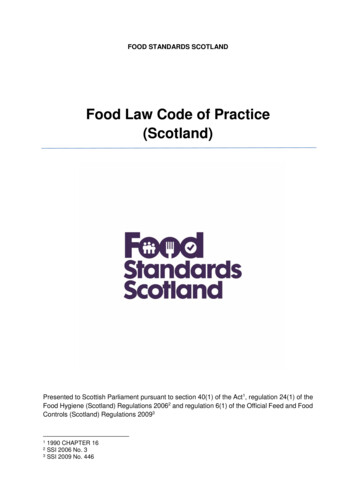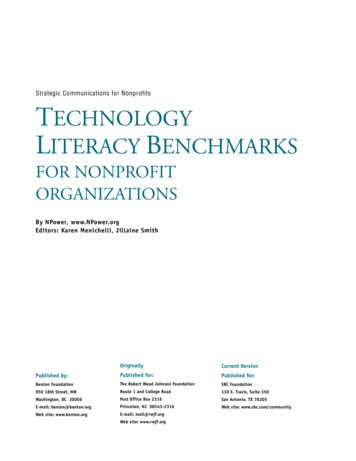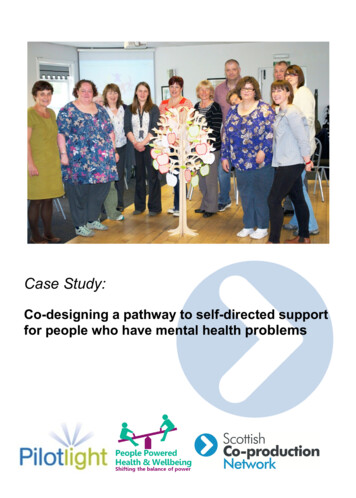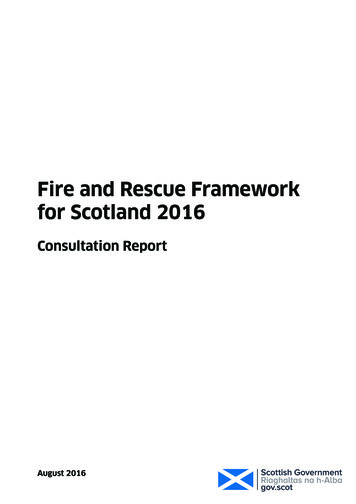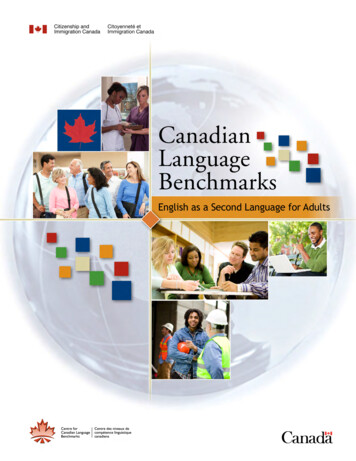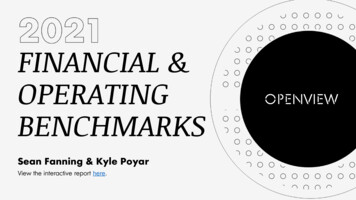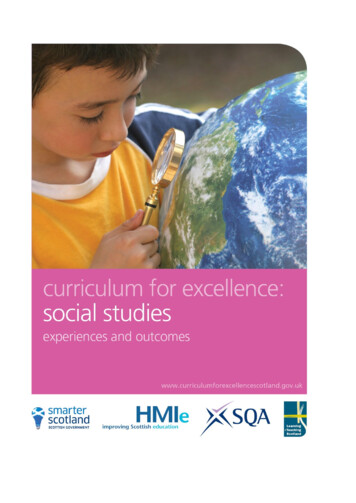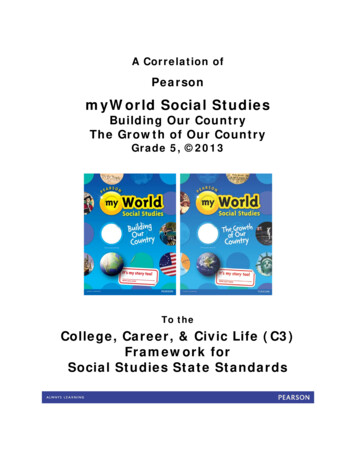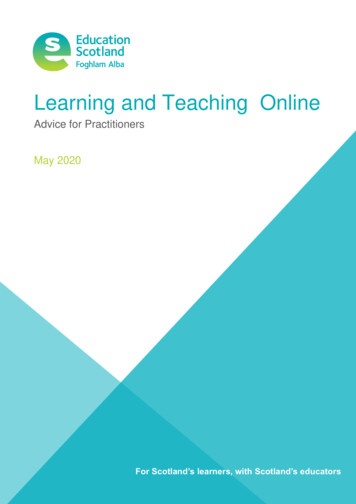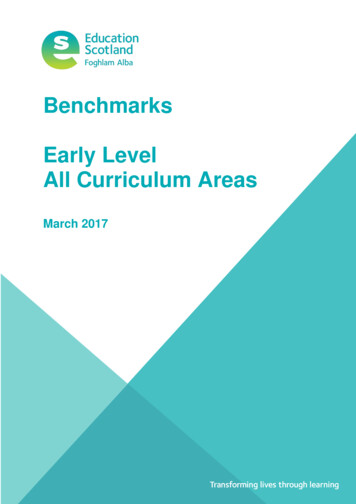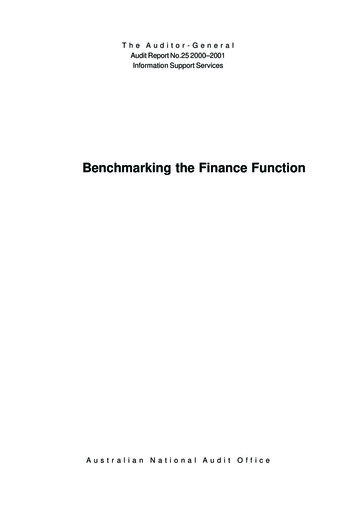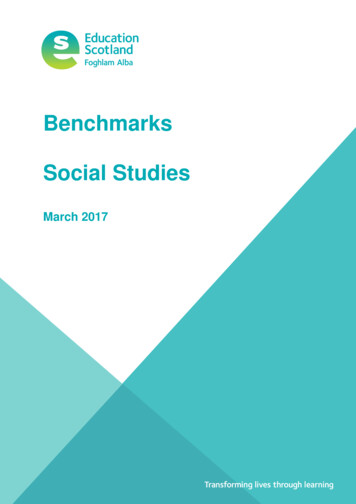
Transcription
BenchmarksSocial StudiesMarch 20171
Education ScotlandGuidance on using Benchmarks for AssessmentMarch 2017Education Scotland’s Curriculum for Excellence (CfE) Statement for Practitioners(Aug 2016) stated that the two key resources which support practitioners to plan learning,teaching and assessment are: Experiences and OutcomesBenchmarksBenchmarks have been developed to provide clarity on the national standards expectedwithin each curriculum area at each level. They set out clear lines of progression in literacyand English and numeracy and mathematics, and across all other curriculum areas fromEarly to Fourth Levels (First to Fourth Levels in Modern Languages). Their purpose is tomake clear what learners need to know and be able to do to progress through the levels,and to support consistency in teachers’ and other practitioners’ professional judgements.Skills development is integrated into the Benchmarks to support greater sharedunderstanding. An understanding of skills and how well they are developing will enablelearners to make links between their current learning and their future career options andemployment.Benchmarks draw together and streamline a wide range of previous assessment guidance(including significant aspects of learning, progression frameworks and annotated exemplars)into one key resource to support teachers’ and other practitioners’ professional judgementof children’s and young people’s progress across all curriculum areas.Benchmarks have been designed to support professional dialogue as part of themoderation process to assess where children and young people are in their learning.They will help to support holistic assessment approaches across learning. They shouldnot be ticked off individually for assessment purposes.Benchmarks for literacy and numeracy should be used to support teachers’ professionaljudgement of achievement of a level. In other curriculum areas, Benchmarks supportteachers and other practitioners to understand standards and identify children’s andyoung people’s next steps in learning. Evidence of progress and achievement willcome from a variety of sources including: observing day-to-day learning within the classroom, playroom or working area; observation and feedback from learning activities that takes place in otherenvironments, for example, outdoors, on work placements; coursework, including tests; learning conversations; and planned periodic holistic assessment.2
Benchmarks in curriculum areasBenchmarks in each curriculum area are designed to be concise and accessible, withsufficient detail to communicate clearly the standards expected for each curriculum level.Teachers and other practitioners can draw upon the Benchmarks to assess the knowledge,understanding, and skills for learning, life and work which children are developing in eachcurriculum area.In secondary schools, Benchmarks can support subject specialist teachers in makingrobust assessments of learners’ progress and the standards they achieve. They willhelp teachers ensure that learners make appropriate choices and are presented at anappropriate level for National Qualifications in the senior phase. This can help avoidexcessive workload for teachers and unnecessary assessments for learners. For example,learners should have achieved relevant Fourth level Experiences and Outcomes beforeembarking on the National 5 qualifications. Schools should take careful account of thiswhen options for S4 are being agreed. Benchmarks should be used to help with theseimportant considerations.Literacy and numeracyIn literacy and numeracy, Benchmarks support teachers’ professional judgement ofachievement of a level. Teachers’ professional judgements will be collected and publishedat national, local and school levels. It is important that these judgements are robust andreliable. This can only be achieved through effective moderation of planning learning,teaching and assessment.Achievement of a level is based on teacher professional judgement, well informed by a widerange of evidence. Benchmarks should be used to review the range of evidence gatheredto determine if the expected standard has been achieved and the learner has: achieved a breadth of learning across the knowledge, understanding and skillsas set out in the experiences and outcomes for the level;responded consistently well to the level of challenge set out in the Experiencesand Outcomes for the level and has moved forward to learning at the next levelin some aspects; anddemonstrated application of what they have learned in new and unfamiliarsituations.It is not necessary for learners to demonstrate mastery of every individual aspect of learningwithin Benchmarks at a particular level and before moving on to the next level. However,it is important that there are no major gaps in children’s and young people's learning whenlooking across the major organisers in each curriculum area.3
Planning learning, teaching and assessment using the BenchmarksIn addition to the Curriculum for Excellence (CfE) Statement for Practitioners fromHM Chief Inspector of Education, August 2016 on the purpose and use of Benchmarks,teachers and other practitioners should note the following advice.KEY MESSAGES – WHAT TO DOKEY MESSAGES – WHAT TO AVOID Use literacy and numeracy Benchmarksto help monitor progress towardsachievement of a level, and to supportoverall professional judgement of whena learner has achieved a level. Avoid undue focus on individualBenchmarks which may resultin over-assessing or recordingof learners’ progress. Become familiar with other curriculumarea Benchmarks over time. Avoid the requirement to spend timecollating excessive evidence to assesslearners’ achievement. Use Benchmarks to help assess whetherlearners are making suitable progresstowards the national standards expectedand use the evidence to plan their next,challenging steps in learning.Discuss Benchmarks within andacross schools to achieve a sharedunderstanding of the national standardsexpected across curriculum areas. There is no need to provide curriculumlevel judgements in all curriculum areas– stick to literacy and numeracy. Do not create excessive or elaborateapproaches to monitoring and tracking. Do not assess Benchmarks individually.Plan periodic, holistic assessment ofchildren’s and young people’s learning. Do not tick off individual Benchmarks. 4
Early Level Social StudiesCurriculumOrganisersPeople, pastevents andsocietiesExperiences and Outcomes for planning learning,teaching and assessmentI am aware that different types of evidence can helpme to find out about the past.SOC 0-01aI can make a personal link to the past by exploring itemsor images connected with important individuals or specialevents in my life.SOC 0-02aI have explored how people lived in the past and have usedimaginative play to show how their lives were different frommy own and people around me.SOC 0-04aPeople,place andenvironmentI explore and discover the interesting features of my localenvironment to develop an awareness of the world aroundme.SOC 0-07aI explore and appreciate the wonder of naturewithin different environments and have playeda part in caring for the environment.SOC 0-08aI have experimented with imaginative ways such asmodelling and drawing, to represent the world around me,the journeys I make and the different ways I can travel.SOC 0-09aWhile learning outdoors in differing weathers, I havedescribed and recorded the weather, its effects andhow it makes me feel and can relate my recordingsto the seasons.SOC 0-12a5 Benchmarks to support practitioners’ professionaljudgement of achievement of a levelIdentifies at least two different types of evidence whichcan provide information about the past, for example,pictures, family stories, artefacts.Recalls past events from their own life or that of theirfamily, for example learning to ride a bike, a specialparty.Recognises that people in the past lived differently.Uses knowledge of the past to demonstrate a differencebetween their life today and life in the past. For example,diet, lifestyle, clothing. Identifies simple features of the local environment,for example, hill, river, road, railway. Identifies different methods of taking journeys. Expresses thoughts about which ways of travellingimpact the environment both positively and negatively. Talks about something they have done to care for theenvironment. Draws or produces simple models of aspects of the localarea, for example roads or buildings. Draws a simple map, or shares a relevant experienceof the route of a straightforward journey, and the methodof transport which was used. Names and talks about at least two different kindsof weather. Draws pictures to record the weather for three days. Describes how weather affects the activities theycan undertake. Talks about how they feel about different kindsof weather.
Peoplein society,economyand businessI am aware that different types of evidence can help me tofind out about the world around me.SOC 0-15aBy exploring my local community, I have discovered thedifferent roles people play and how they can help.SOC 0-16aI make decisions and take responsibility in my everydayexperiences and play, showing consideration for others.SOC 0-17aWithin my everyday experiences and play I make choicesabout where I work, how I work and who I work with.SOC 0-18aIn real-life and imaginary play, I explore how local shopsand services provide us with what we need in our daily lives.SOC 0-20a6 Describes which weather is likely to be related to whichseason. Identifies at least two sources of evidence which provideinformation about the world, for example, newspapersand television. Identifies at least two people who provide help in thecommunity. Talks about ways that each of those people help. Takes on appropriate roles during imaginative play. Identifies at least two different types of shopsor services families might use, for example,supermarket or health centre.
First Level Social StudiesCurriculumOrganisersPeople, pastevents andsocietiesExperiences and Outcomes for planning learning,teaching and assessmentI understand that evidence varies in the extent to which itcan be trusted and can use this in learning about the past.SOC 1-01a By exploring places, investigating artefacts and locatingthem in time, I have developed an awareness of the waysin which we remember and preserve Scotland’s history.SOC 1-02a I can use evidence to recreate the story of a placeor individual of local historical interest.SOC 1-03a Benchmarks to support practitioners’ professionaljudgement of achievement of a levelIdentifies the difference between a more and lesstrustworthy source.Draws a short timeline and can locate two or moreevents on the line in the correct order.Uses information learned from sources to relate the storyof a local place or individual of historic interest thoughmedia such as drawings models or writing.Draws comparisons between modern life and life froma time in the past.Names a figure from the past and commentson their role in events.I can compare aspects of people’s daily lives in the pastwith my own by using historical evidence or the experienceof recreating an historical setting.SOC 1-04aHaving selected a significant individual from the past, I cancontribute to a discussion on the influence of their actions,then and since.SOC 1-06aPeople,place andenvironmentI can describe and recreate the characteristics of my localenvironment by exploring the features of the landscape.SOC 1-07aI can consider ways of looking after my school or communityand can encourage others to care for their environment.SOC 1-08aHaving explored the variety of foods produced in Scotland,I can discuss the importance of different types of agriculturein the production of these foods.SOC 1-09a7 Draws or makes a model of features in their locallandscape, for example, hill, river, building. Identifies a way in which the school looks afterits environment. Identifies at least two forms of agriculture in Scotlandand foods associated with these, for example, arable,dairy or pastoral. Identifies at least two different types of housingand the kinds of households who may inhabit them. Uses instruments to measure and record at least twodifferent weather elements, for example, temperature,rainfall, wind direction.
By exploring my community and the groups within it, I canidentify and consider different types of housing and howthey meet needs.SOC 1-11aBy using a range of instruments, I can measure and recordthe weather and discuss how weather affects my life.SOC 1-12aBy exploring climate zones around the world, I can compareand describe how climate affects living things. SOC 1-12b Contributes to a discussion giving reasoned opinionson how the weather affects life. Draws two conclusions about how living things adaptto the climate in any chosen area. Describes at least three different ways in which landis used in the local area, for example shops, houses,farming. Draws at least two conclusions as to the effectsthe landscape has had on how people can use it,for example desert, rainforest. Produces a basic map for a familiar journey.Having explored the landscape of my local area, I candescribe the various ways in which the land has been used.SOC 1-13aBy exploring a natural environment different from my own,I can discover how the physical features influence thevariety of living things.SOC 1-13bPeople insociety,economy andbusinessThrough activities in my local area, I have developed mymental map and sense of place. I can create and use mapsof the area.SOC 1-14aI understand that evidence varies in the extent to which itcan be trusted and can use this in learning about currentissues in society.SOC 1-15aI can contribute to a discussion of the difference betweenmy needs and wants of those of others around me.SOC 1-16aBy exploring the ways in which we use and need rules,I can consider the meaning of rights and responsibilitiesand discuss those relevant to me.SOC 1-17a8 Identifies a reliable and an unreliable sourceof evidence. Identifies needs and wants using examplesfrom their own experience. Presents an informed opinion on rights andresponsibilities using their own experience. Makes informed decisions on an issue having listenedto others. Names two local organisations who provide for needsin the local community and describe what they do. Demonstrates relevant numeracy skills to do a simplebudget.
I have participated in decision making and have consideredthe different options available in order to make decisions.SOC 1-18aI have developed an understanding of the importanceof local organisations in providing for the needs of mycommunity.SOC 1-20aI can work out the amount of money I need to buy items,understanding that I may not always be able to afford theitems I want.SOC 1-21aI have experienced the different jobs involved in runninga business enterprise and understand the role each onesplays in its success.SOC 1-22a9 Describes at least two different types of jobsand give a reason why each contributes to thesuccess of the business or enterprise.
Second Level Social StudiesCurriculumOrganisersPeople, pastevents andsocietiesExperiences and Outcomes for planning learning,teaching and assessmentI can use primary and secondary sources selectivelyto research events in the past.SOC 2-01aI can interpret historical evidence from a range of periodsto help build a picture of Scotland’s heritage and my senseof chronology.SOC 2-02aI can investigate a Scottish historical theme to discoverhow past events or the actions of individuals or groupshave shaped Scottish society.SOC 2-03a Benchmarks to support practitioners’ professionaljudgement of achievement of a levelUses both primary and secondary sources of evidencein an investigation about the past.Places an event appropriately within a historical timeline.Describes at least two ways in which past events or theactions of individuals or groups have shaped Scottishsociety.Describes and discusses at least three similarities anddifferences between their own life and life in a pastsociety.Contributes two or more points to the discussion(in any form) as to why people and events fromthe past were important.Places those people and events on a timeline.I can compare and contrast a society in the past withmy own and contribute to a discussion of the similaritiesand differences.SOC 2-04aPeople,place andenvironmentI can discuss why people and events from a particular timein the past were important, placing them within a historicalsequence.SOC 2-06aI can describe the major characteristic features ofScotland’s landscape and explain how these are formed.SOC 2-07a I can describe the physical processes of a natural disasterand discuss its impact on people and the landscape.SOC 2-07b10 Identifies at least three features of Scotland’slandscape and can provide a basic explanationof how these are formed.Describes the causes of a natural disaster suchas a volcano, earthquake or extreme weather event.Describes the impact of the natural disaster givingat least three examples for people and one for thelandscape. Impact can be positive or negative.
I can discuss the environmental impact of humanactivity and suggest ways in which we can livein a more environmentally-responsible way. SOC 2-08a I can consider the advantages and disadvantagesof a proposed land use development and discussthe impact this may have on the community.SOC 2-08bHaving explored the ways journeys can be made,I can consider the advantages and disadvantagesof different forms of transport, discussing their impacton the environment.SOC 2-09aHaving explored my local area, I can present informationon different places to live, work and relax and interestingplaces to visit.SOC 2-10aBy comparing my local area with a contrasting areaoutwith Britain, I can investigate the main features ofweather and climate discussing the impact on living things.SOC 2-12aI can explain how the physical environment influencesthe ways in which people use land by comparing my localarea with a contrasting area.SOC 2-13aTo extend my mental map and sense of place, I caninterpret information from different types of maps andam beginning to locate key features within Scotland,UK, Europe or the wider world.SOC 2-14a11 Identifies at least three impacts of human activityon the environment.Suggests at least three ways in which peoplecan live in a more environmentally responsible way.Describes at least two advantages and twodisadvantages of a land use development proposal.Explores at least two impacts on the community eitherverbally or in writing.Identifies at least four ways in which journeyscan be made.Describes at least one advantage and disadvantagefor each form of transport.Shares knowledge about the impact of the varioustypes of transport on the environment either verballyor in writing.Presents information in any preferred form on thelocal area including local area names, two majoremployers/types of employment, for example,call centres, local attractions, leisure facilities.Compares and contrasts the differing effects of theweather on the people and society of Britain and acontrasting area, providing at least three similaritiesand/or differences.Provides explanation as to why their local physicalenvironment influences the way in which people useland in comparison to a contrasting areas.Extracts information from more than one kind of map.Locates continent names, country names, capital cities,rivers and railways on maps of Scotland, the UK,Europe and areas further afield.
Peoplein society,economyand businessI can use evidence selectively to research current social,political or economic issues.SOC 2-15aI can explain how the needs of a group in my localcommunity can be supported.SOC 2-16aI can gather and use information about formsof discrimination against people in societies andconsider the impact this has on people’s lives.SOC 2-16bI can discuss issues of the diversity of cultures,values and customs in our society.SOC 2-16cI can describe the main features of a democracyand discuss the rights and responsibilities of citizensin Scotland.SOC 2-17aI can investigate the features of an election and the workof representatives at a local, national or European levelto begin to develop my understanding of how democracyworks.SOC 2-18aBy comparing the lifestyle and culture of citizens in anothercountry with those of Scotland, I can discuss the similaritiesand differences.SOC 2-19a12 Selects appropriate evidence and uses it to researcha social, political or economic issue. Provides a basic explanation as to how the needsof a particular group within the local communitycan be supported, using relevant examples. Uses evidence to form a valid opinion of the impactof discrimination or prejudice on people’s lives,for example, racism or the effect of immigration. Discusses in any form at least three issues related tocultures, values and customs in our society, for example,the role of family, traditions and gender stereotyping. Describes the main features of a democracy. Identifies links between rights and responsibilities. Presents information (in any preferred form) aboutthe features of local, national or European electionsand discusses the work of the appropriaterepresentative. Compares and contrasts the lifestyle and cultureof the citizens of Scotland as compared to the citizensof another country. Describes the basic needs of human beings. Draws valid conclusions as to why some countriescan meet these needs better than others. Identifies which goods and services would be essentialin society. Describes the main ways of paying for goods andservices acknowledging that there may be advantagesand disadvantages of each method. Describes and pros and cons of using Fairtrade productsand community service providers such as credit unions. Identifies the main business functions such asproduction, sales, marketing, and administration. Takes a role in setting up or running a small enterprise. Evaluates the success of the enterprise.
Through exploring ethical trading, I can understand howpeople’s basic needs are the same around the world,discussing why some societies are more able to meetthese needs than others.SOC 2-20aI can identify essential goods and services, discuss thedifferent ways to pay for them, considering the benefitsand risks of each method.SOC 2-21aBy experiencing the setting up and running of a business,I can collaborate in making choices relating to the differentroles and responsibilities and have evaluated its success.SOC 2-22a13 Identifies profit and non-profitmakingorganisations/enterprises including those who servicesare free at the point of delivery, for example health andeducation.
Third Level Social StudiesCurriculumOrganisersPeople, pastevents andsocietiesExperiences and Outcomes for planning learning,teaching and assessmentI can use my knowledge of a historical period to interpretthe evidence and present an informed view.SOC 3-01a I can make links between my current and previous studies,and show my understanding of how people and eventshave contributed to the development of the Scottish nation.SOC 3-02aI can explain why a group of people from beyond Scotlandsettled here in the past and discuss the impact they havehad on the life and culture of Scotland.SOC 3-03a I can explain the similarities and differences betweenthe lifestyles, values and attitudes of people in the past bycomparing Scotland with a society in Europe or elsewhere.SOC 3-04a I can describe the factors contributing to a major social,political or economic change in the past and can assessthe impact on people’s lives.SOC 3-05a I can discuss the motives of those involved in a significantturning point in the past and assess the consequencesit had then and since.SOC 3-06a14 Benchmarks to support practitioners’ professionaljudgement of achievement of a levelCompares a range of primary and secondary sourcesof evidence, to present at least three valid conclusionsabout a historical period.Draws on previous work to provide a simple explanationof how people and events have contributed to thedevelopment of the Scottish nation. Providing at leasttwo reasoned conclusions.Provides at least two simple explanations as to whya group of people from beyond Scotland settled here.Describes at least two impacts immigrants have hadon life and culture of Scotland.Provides an account with at least two simpleexplanations as to how and why society has developedin different ways comparing Scotland to another societyin Europe or elsewhere.Identifies at least three factors which contributed to amajor social, economic or political change in the past.Provides at least two valid opinions about the impacton people’s lives of a major social economic or socialchange in the past.Provides at least two valid opinions about the possiblemotives of those involved in a significant turning pointor event in history.Provides a valid opinion of the impact of this significanthistorical event.Identifies at least two possible causes of past conflict,using research methods.Presents in any appropriate form at least two impactson people at that time.
People,place andenvironmentThrough researching, I can identify possible causesof a past conflict and report on the impact it has hadon the lives of people at that time.SOC 3-06bHaving investigated processes which form and shapelandscapes. I can explain their impact on selectedlandscapes in Scotland, Europe and beyond.SOC 3-07aI can identify the possible consequences of anenvironmental issue and make informed suggestionsabout ways to manage the impact.SOC 3-08aI can investigate the climate, physical features and livingthings of a natural environment different from my own andexplain their interrelationship.SOC 3-10aI can compare the social and economic differences betweenmore and less economically-developed countries and candiscuss the possibilities for reducing these differences.SOC 3-11aI can investigate the relationship between climateand weather and be able to understand the causesof weather patterns within a selected climate zone.SOC 3-12aBy comparing settlement and economic activity in twocontrasting landscapes. I can reach conclusions abouthow landscapes influence human activity. I can explainmy findings clearly to others.SOC 3-13a15 Identifies the processes which form landscapes acrossthe world.Provides a simple explanation of at least threeprocesses involved in the development of anychosen landscape, for example, coasts, volcanic, riversor glaciated.Provides a simple explanation of at least threeconsequences of an environmental issue, andfor each suggest how they could be managed.Describes a natural environment different to their own,in terms of climate, physical features and living things.Provides a simple explanation of at least three linksbetween climate, physical features and living thingsin that environment.Identifies at least three social and economic differencesbetween developed and developing countries, forexample infant mortality rate, % adult literacy rate,Gross National Product per capita.Suggests possible ways these differences would bereduced, and provide valid opinions as to their likelysuccess.Demonstrates a basic understanding of the relationshipbetween weather and climate.Provides a simple explanation for a weather patternwithin a selected climate zone, for example, convectionrainfall in the rainforest.Provides at least two explanations as to howlandscapes influence human activity, using twocontrasting areas.
I can use a range of maps and geographical informationsystems to gather, interpret and present conclusions andcan locate a range of features within Scotland, UK, Europeand the wider world.SOC 3-14a Peoplein society,economyand businessI can use my knowledge of current social, politicalor economic issues to interpret evidence and presentan informed view.SOC 3-15a I can explain why a group I have identified might experienceinequality and can suggest ways in which this inequalitymight be addressed.SOC 3-16a I have compared the rights and responsibilities of citizensin Scotland with a contrasting society and can describeand begin to understand reasons for differences.SOC 3-17a I can discuss the extent to which my choices and decisionsare influenced by the ways in which I am informed.SOC 3-17bI can understand the arrangements for political decisionmaking at different levels and the factors which shapethese arrangements.SOC 3-18a16 Reviews at least two simple graphical sourcesto interpret information and form a conclusion,for example, a map and a graph.Uses relevant numeracy and digital technology skillsto interpret at least two sources of data from mapsand graphical information systems.Locates increasingly complex features such as differentphysical landscape features and human features onmaps of Scotland, the UK, Europe and the wider worldfor example, hills, mountains, valleys, population.Reviews basic sources of evidence such as newspapersor surveys used in arguments about current affairs toform a valid opinion.Presents using appropriate methods an informedview of a current affairs issue.Provides at least two simple explanations as to whya selected group might experience inequality, forexample gender, race/ethnicity, age, disability.Makes two or more reasoned suggestions of waysin which this inequality might be addressed.Identifies their own rights and responsibilitiesas a Scottish citizen and makes a comparisonwith a contrasting society.Gives at least two simple explanations for thedifferences between their own rights and responsibilitiesand those in a contrasting society.Identifies at least three sources of information thatinfluence the ways in which he/she is informed.Provides at least two valid opinions about the waysin which choices and decisions might be influencedby bias or exaggeration.Describ
SOC 1-02a I can use evidence to recreate the story of a place or individual of local historical interest. SOC 1-03a I can compare aspects of people's daily lives in the past with my own by using historical evidence or the experience of recreating an historical setting. SOC 1-04a Having selected a significant individual from the past, I can
